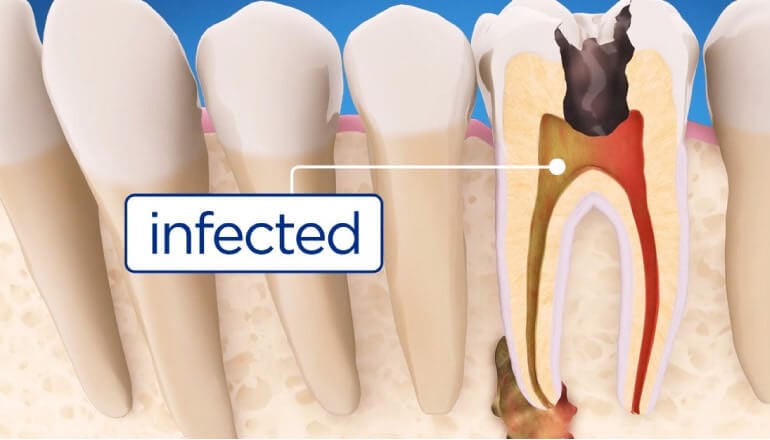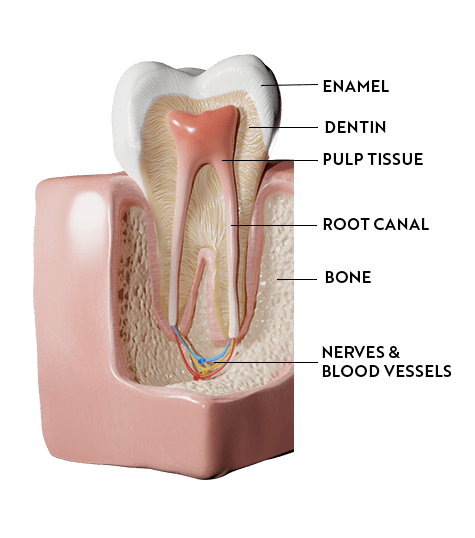What To Expect During Your First Root Canal

Have you ever wondered what to expect during your first root canal? Many people are apprehensive about this dental procedure, as it’s often associated with pain and discomfort. But it doesn’t have to be that way! In this article, we’ll be exploring the experience of a root canal, so you know exactly what to expect when you go in for yours.
Root canals are necessary when a tooth has become severely infected or decayed. During the procedure, the dentist will remove the infected pulp and nerve from inside the tooth before sealing it up. The first step of a root canal is typically numbing the area around the tooth with an injection of local anesthesia. This helps make sure you don’t feel any pain during the procedure.
Once your mouth is numb, your dentist will use special tools to access and clean out the infection inside your tooth. This includes removing any debris, bacteria, and dead tissue that may be present in order for them to properly seal off the canal. After that, they’ll fill in the space vacated by removing all of those materials with a special material called gutta percha. Finally, they’ll put in a crown or filling to protect your newly restored tooth from further damage or decay.
Overview Of The Root Canal Procedure
Root canals can be a scary prospect for anyone, due to the unknown. But understanding what to expect during your first root canal procedure can help alleviate any worries you may have.
A root canal is a common dental procedure used to treat infected or damaged teeth, and is typically done in one visit. To put it into perspective, the American Association of Endodontists estimates that 25 million root canals are performed each year in the United States alone.
During your first root canal, your dentist will numb the area around your tooth before beginning any treatment. Afterward, they will make an opening in the top of your tooth to access the pulp chamber and nerve roots inside. Next, they will use special tools to remove all traces of infection and decay from within the pulp chamber.
Once this is done, they will fill the cavity with a biocompatible material like gutta-percha and seal it shut with cement or another material to protect it from further damage.
Finally, you’ll receive a crown or other restoration to help restore your tooth’s original shape and function. With proper care and maintenance, most root canals last 10-15 years before needing replacement or repair.
Reasons For A Root Canal
Root canals are often a necessary dental procedure due to the irreversible damage caused by infected or decayed teeth. Below are some of the reasons why a root canal is needed:
- Pain: If you experience extreme pain when your tooth is touched or when chewing, it could be an infection.
- Swelling: If you have swelling in your gums or cheeks, it could be a sign of an infection.
- Discoloration: Your tooth may become discolored or even darker if it is infected.
It’s important to remember that just because you have one of these symptoms doesn’t necessarily mean that you need a root canal. Your dentist will examine your mouth and take X-rays to determine if a root canal is necessary.
After the examination, they may recommend a different treatment option such as antibiotics or fillings instead. No matter what your dentist recommends, it’s important to follow their instructions for proper care and maintenance of your teeth and gums. Taking care of your oral health now can help prevent future problems from arising.
Preparation For The Procedure
Before having a root canal, your dentist will examine the affected tooth and take X-rays to determine if you need a root canal. They’ll likely also ask about any medical conditions or medications you’re taking, to ensure that the procedure is safe for you.
On the day of your root canal, your dentist will numb the area around the tooth with local anaesthesia to ensure that you don’t feel any pain during the procedure. Once this is done, they’ll use a dental drill to create an opening in the top of your tooth so they can access your pulp chamber.
You may hear some noise from the drill, but it won’t be painful because of the anaesthesia. Your dentist may also put a rubber dam over your teeth to keep them clean and free of saliva during the procedure. At this point, they’ll be ready to begin removing any infected tissue in your root canal and cleaning it out with special tools.
Types Of Anesthetic Used
Root canals are often thought of as a painful procedure, but dentists use anesthetics to reduce any discomfort. There are two main types of anesthetics used during root canal procedures: local and general.
Local anesthetics are used to numb the area around the affected tooth. This is done by injecting a numbing solution into the gum or directly into the tooth. Local anesthetics work quickly and typically last for several hours after the procedure is finished.
General anesthetics, on the other hand, put you in a deep sleep so that you won’t feel any pain during the procedure. These types of anesthetics are usually only used if multiple teeth need to be treated or if there are medical reasons why a patient cannot have local anesthetic. In these cases, it’s important to make sure that all safety precautions and protocols are followed before administering general anesthesia.
No matter which type of anesthetic is used during your root canal procedure, it’s important to discuss all of your options with your dentist ahead of time so that you can make an informed decision about your treatment plan.
Post-Procedure Care And Recovery
After your first root canal, it is important to take good care of yourself and the treated area so that it can heal properly. You should avoid chewing on the side that was treated and rinse with salt water several times a day for the first few days. Eating soft foods can help reduce any discomfort, as well as taking over-the-counter pain medications such as ibuprofen or acetaminophen if needed.
It is also important to attend any follow-up appointments your dentist has scheduled for you, which will likely include an x-ray to ensure the infection has been completely cleared up. Your dentist may also provide you with a special dental sealant or crown, depending on the condition of your tooth. This will help protect and preserve your tooth in the future. Taking these steps will ensure that you have a successful recovery from your root canal procedure.
Potential Complications
Though it may be intimidating to think about, the prospect of complications arising during a root canal is very rare. The procedure is performed by experienced dentists and endodontists who use the most advanced technology and techniques available. However, it’s important to be aware that there are some potential risks associated with this type of dental care.
The most common complication following a root canal is infection, which can occur if the affected tooth isn’t cleaned properly. Depending on the severity of the infection, antibiotics may be needed to help clear up the issue and restore oral health. In addition, some patients may experience discomfort or swelling in the area after their treatment has been completed. If these symptoms don’t improve over time, another visit to your dentist should be scheduled for further evaluation.
Root canals are normally a safe and effective way to treat severe dental issues and restore oral health. With proper preparation, care and follow-up visits, you can ensure that you receive quality treatment with minimal risk of experiencing any complications.
Risks To Consider
Root canals can be a safe and effective way of treating tooth decay, but there are risks to consider. For example, during the procedure, your dentist may accidentally damage the root of the tooth or the surrounding tissue. In addition, you may experience some pain, swelling, or bleeding after the procedure. It is important to discuss any concerns you have with your dentist before going through with the root canal so that they can ensure your safety.
Also, if you have an existing dental condition such as gum disease or cavities, these must be addressed prior to a root canal in order for it to be successful. Without proper treatment of existing conditions, a root canal could further harm your teeth and gums.
Therefore, it is essential that you communicate any pre-existing issues to your dentist and get them treated first. Taking these steps will help ensure that your root canal goes smoothly and without complications.
Cost And Insurance Coverage
The cost of a root canal can vary depending on the complexity of the procedure and the specific dentist you visit. Fortunately, most dental insurance plans cover at least part of the cost. It’s a good idea to check with your insurance provider before scheduling an appointment to ensure that your plan covers the entire procedure or understand what portion of it may be out-of-pocket.
When making payment arrangements, many dentists offer financing options or accept credit cards. This can make paying for a root canal more manageable if you don’t have insurance coverage. Additionally, some dental offices may provide discounts if you pay in full at the time of service. Be sure to ask about these options when discussing fees with your dentist ahead of time.
Alternatives To A Root Canal
Once you’ve explored the cost and insurance coverage options for a root canal, you may be wondering what to expect should you decide to move forward with treatment. There are alternatives to a root canal, such as extracting the tooth or doing nothing at all, but your dentist will discuss these with you if needed.
Your first appointment for a root canal will involve numbing the area around the infected tooth and cleaning out any infection from inside the tooth. Depending on how severe your infection is, your dentist may perform one or multiple appointments over a few weeks. During each appointment, they’ll work to clean out any living bacteria or tissue that’s affected by decay before filling and sealing the tooth. Afterward, they’ll place a crown on top of the tooth in order to protect it and restore its functionality.
The whole process can take several hours depending on how complex your case is. You may experience some swelling or soreness following your procedure, which should subside after a couple days. Your dentist will likely prescribe antibiotics and pain medication to help manage any discomfort during this time. It’s important that you follow their instructions carefully in order to ensure proper healing and avoid any potential complications.
Questions To Ask Your Dentist
Have you ever wondered what questions to ask your dentist before a root canal? It’s important to understand the process and be prepared for what will take place during the procedure. Here are five key questions to ask before undergoing your first root canal:
| Questions | Answers |
|---|---|
| What is the expected duration of the procedure? | The procedure usually takes between one and two hours, depending on complexity. |
| What type of anesthesia will be used? | Most dentists use local anesthetic such as lidocaine or Novocain. Some may also use nitrous oxide or oral sedation. |
| Will I need a follow-up appointment? | Yes, most likely. Your dentist will want to check that everything is healing properly and make any adjustments if necessary. |
| Are there any risks associated with the procedure? | Root canals are generally safe procedures but there is a small risk of infection or tooth fracture. Your dentist can discuss these risks with you before starting the procedure. |
| What should I expect after the root canal? | After a root canal, you may experience some mild discomfort and swelling for a few days afterwards, but this should improve quickly with over-the-counter pain medications and cold compresses. You should start to feel better within a week or two. |
Asking your dentist these questions can help put your mind at ease and ensure that you’re well-prepared for your first root canal experience. Be sure to voice any concerns that you have so that they can be addressed prior to beginning treatment. With the right preparation, you can rest assured that your root canal procedure will go smoothly!
What To Expect After The Procedure
Now that you know what to expect during your first root canal treatment, it’s time to look at what happens after the procedure. After the root canal is complete, the dentist will insert a temporary filling into the tooth. This is done to protect the tooth while your permanent restoration is being made.
The permanent restoration can take a few weeks to be ready and may involve either a crown or an onlay, depending on the extent of damage caused by the infection. Once in place, this restoration will help protect your tooth against further decay and ensure that you can use it normally without any pain or discomfort. Your dentist may advise you to avoid chewing hard foods on that side of your mouth until the restoration has been fully set in place.
Follow-Up Visits
Follow-up visits are an important part of the root canal process. After your first procedure, your dentist will want to check on the progress of your healing. This is usually done at a separate appointment one to two weeks after the initial root canal. During this visit, your dentist will examine the tooth and surrounding tissue for any signs of infection or discomfort. They may also take X-rays to make sure that everything is progressing as expected.
Your dentist may also remove any temporary filling that was put in place during the initial procedure and replace it with a permanent one. Depending on how your tooth responds to the treatment, you may need additional treatments such as a crown or post and core build-up to ensure long-term success. You can expect your follow-up visits to be shorter than your first appointment but they will still be essential for monitoring your progress and ensuring that you receive the best care possible.
Conclusion
In conclusion, root canals are a common dental procedure that can save your tooth from the painful symptoms of infection or decay. As many as 41% of Americans suffer from dental anxiety, which makes it important to be prepared for the procedure and ask any questions you may have before it begins.
I hope this article has helped you understand what to expect during your first root canal. Knowing what to expect can help alleviate some of the anxiety associated with this procedure, enabling you to make an informed decision about whether or not it’s right for you. If a root canal isn’t necessary, there are other options available such as fillings or crowns that your dentist can discuss with you.
Ultimately, remember that root canals are critical in saving teeth and reducing pain and discomfort – so don’t hesitate to talk to your dentist if they recommend one!
So now that you know what to expect during your first root canal, you can go into your appointment feeling more informed and prepared for what lies ahead!











